#cmnh
Explore tagged Tumblr posts
Text

We visited the newly renovated Cleveland Museum of Natural History, and were delighted to find that they kept one of their best easter eggs on display. (Here's a hint if you're having problems finding it.)
29 notes
·
View notes
Text
Okay so my phone was low on battery but suffice to say I'm still a little speechless after meeting Bryce Dallas Howard.
She's 100% Claire. Just. She's phenomenal. She's incredibly Meticulous, first and foremost. She had prints from, I believe, every single piece she's done. I had her sign a Dominion Print AND a Jurassic World print (her with the FLARE, in the purple outfit!) , and then she SIGNED MY BINDER TOO.

I guess the plan now is to bring this binder to every con that has Jurassic Park or Jurassic World guests and have them sign it like a yearbook. Front cover for the JP trilogy, back cover for the JW saga. Look how neatly she signed it.
She also rejected the first signature she did for me, because the marker didn't turn out how she wanted. She didn't like it the first time, so she fixed it, because that's who she is, I guess. Nailed the rest. Got excited when we told her about the holotype T. rex at CMNH, which I clarified is NOT the T. rex at the airport (which she saw and loved!).
Also, if she recalls correctly, the part where she taps on the glass in the Indominus pen was NOT scripted. Not sure if that's 100% accurate, so I'm not an Official Source...but she DID confirm that all Final Takes were done in heels and that she trained for months (though an official interview also confirmed that they used ballet straps to keep her heels attached).
She also couldn't resist flexing on some kids ahead of her who were clad in Grinch attire that her dad directed the live-action movie. Also, her husband was there with her. With much cheaper signatures. That no one was in for. They've been married for about twenty years. Insane husband material.
OH she was also really excited when I mentioned Dichen Lachmann (she corrected me on pronunciation, it's Dee-chen, not Deeken), and expressed great excitement for her role in the animated show, and that she was so talented and great to work with, and also recommended Dollhouse.
Seriously. She's incredible. What a phenomenon.
Oh, also, it took FOREVER in her line because she took her time with every guest. I felt really welcome and she felt genuine, and she was not just brooming anyone off. Incredible. '
13 notes
·
View notes
Text
History Giants: Titanichthys clarki

Ti. clarki is among the largest known placoderms we have fossil record off, remains of their jaws, skull and shield bones are found scattered but some complete specimens offer a complete view of this peculiar and possible first large filter feeding vertebrate from the late devonian. AMNH 7315 or AMNH FF 7134 (IDK why the different ID from Engelman reference) represent one of the biggest known specimens recovered alongside the Moroccan Ti. termieri, having a head length of 75 cm and extended flat a breadth of 1.4 meters.
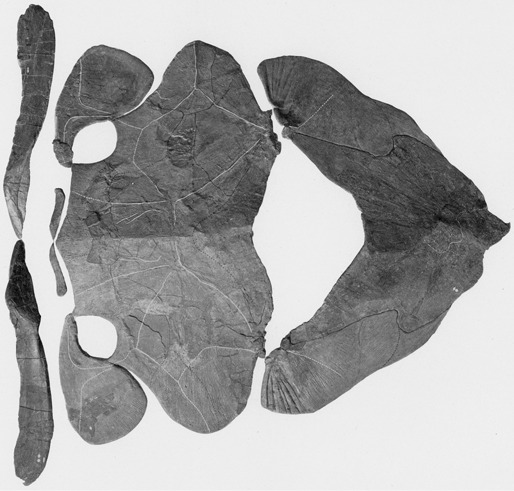
Engelman paper on Dunkleosteus body calculation used the measurements of this specimen alongside the smaller but quite complete CMNH 5768 implementing OOL giving on both specimens a body size of 3.7 and 4.15 meters respectively, making this one of the few placoderms that can rivalice in length to Dunkleosteus.
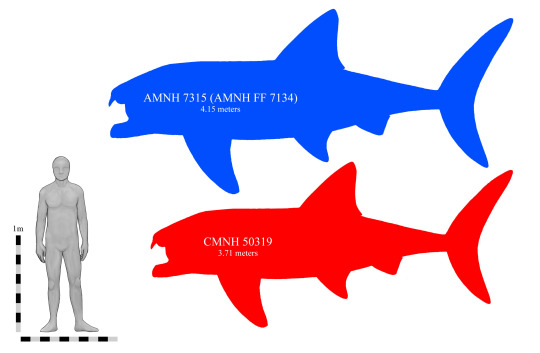
Reconstructing Titanichthys
If you are wondering about some details on this reconstruction looking this way, proportions, shape of the head and the strange "fang" on the front that lacks many recons is because I spend some time trying to check how to reconstruct properly this armored fish, which ended up with this skeletal reconstruction
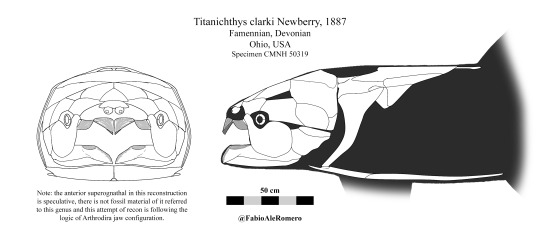
This already comes from what I tried to do several months ago with the need to properly reconstruct this placoderm since the available figures and references seem not to expose several elements, even those that we do know exist which are not often highlighted in the paper skeletal reconstructions. in this case the base of everything is mostly from CMNH 50319, perhaps one of the most complete Titanichthys with material described online (scale bar 1 m)
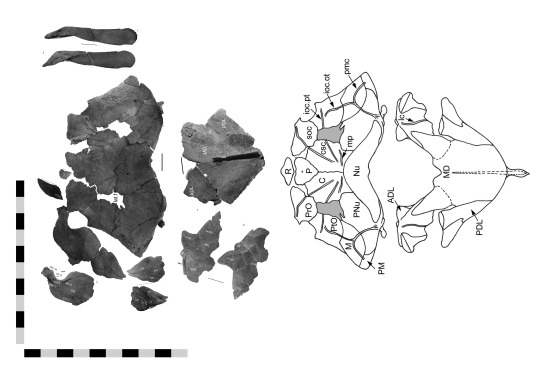
I was not just comfy about doing this reconstruction based only in sketches, so instead on assuming proportions by digital sketches in a 2D way, I spend few weeks working my way into blender and modeling each pieces I did build a basic model from most of the bone that forms the whole skull and thoracic shield bones, the model for the moment is not available anywhere, and I don't think I could share it online for the moment.
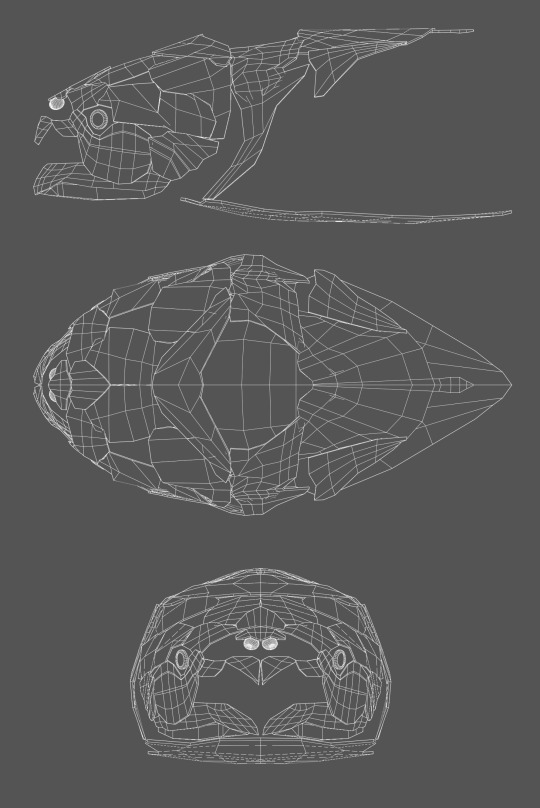
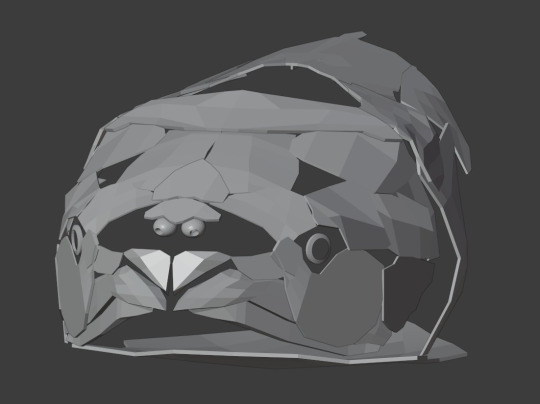
Every minor thing that is not know is being filled with other of its relatives such as Bungartius and Tafilalichthys, both species the most close relatives on few cladistic trees. Unlike the filter feeder, these two are known to might have been hard prey eaters, they are relatively more complete and better preserved so they work out as a reference base being one of the most useful aspects the lacking elements of the jaw.
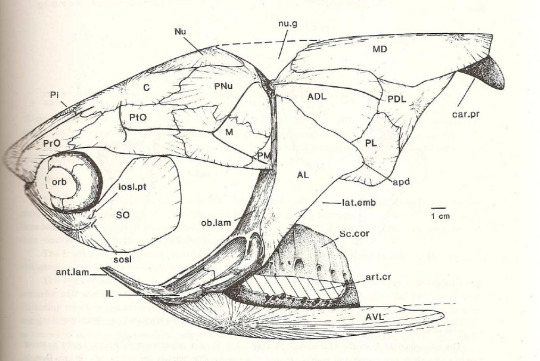
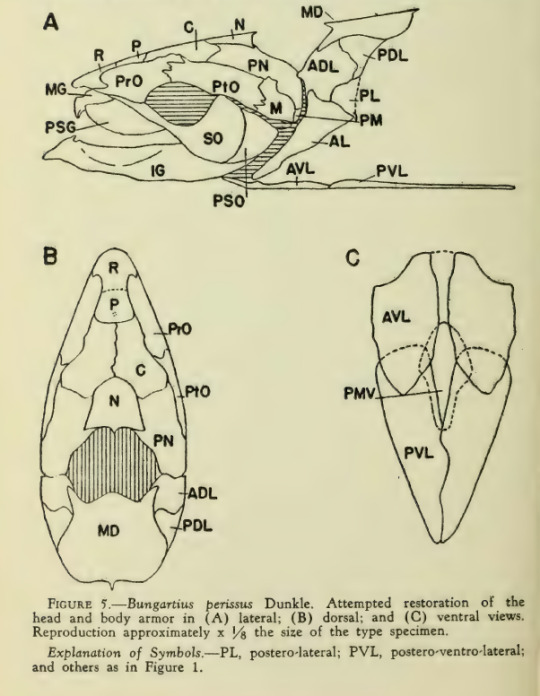
Probably is important to remark a lot of mounts that are used as references are pretty incomplete in the front, with also the lower jaw being backwards, the extreme of the jaws should be touching in V shape and the notch probably was filled with cartilage called a meckel's cartilage.
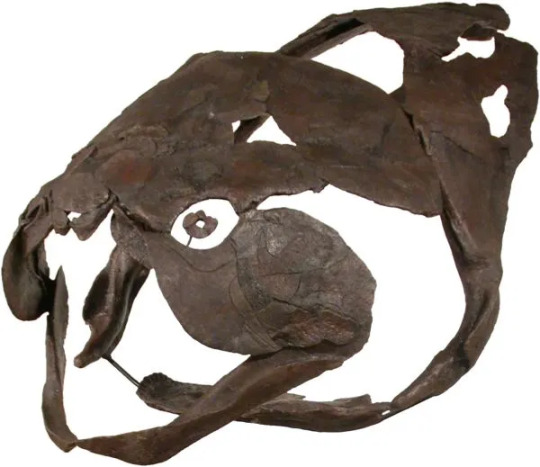
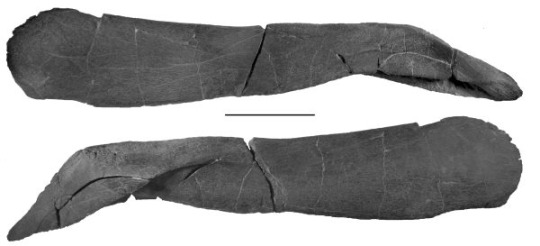
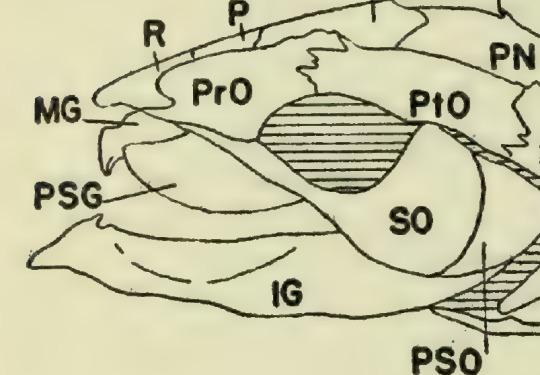

In general picking Bungartius as a sample the upper jaw possess the complete set of superognathal plates, the upper jaw bones that exist on all placoderms, in many species vary in size and shape, which even Titanichthys there is some evidence of a Posterior Supergnathal Plate along the complete specimen (PSG, see above), but not the Anterior (MG or ASG), inferring from the position of both supergnathal and the articulation of the cheek bone where the inferognathal fits, this hypothetically could mark how these bones configurated in the skull.
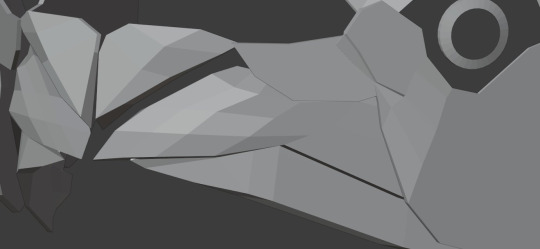
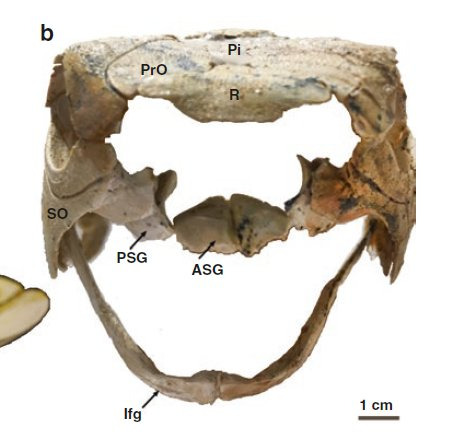
Eye with this, my reconstruction is speculative, based on how these bones articulates on other specimens, new evidence and more material could provide a more accurate conclusion.

Compared to Dunkleosteus is amazing that level of diversity these reached on the last days of the Devonian, both belonging to two totally different radiations of Arthrodira they grew to become the giants of their time, though currently with this body reconstruction Dunk remains very robust on body shape compared to the more compact shaped Titan.
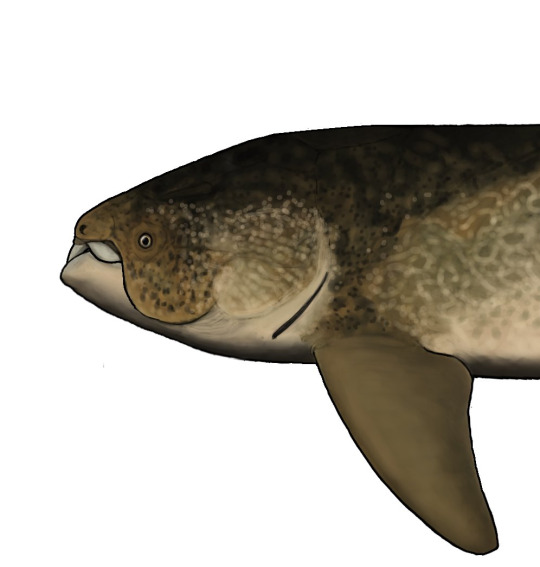
BTW for those curious how it would look like with its jaw closed.
102 notes
·
View notes
Note
i'm the person who posited "all dinosaurs are birds" after your one poll. since then i went to my local museum (cmnh) with my partner and another friend, and suggested my theory to one of the educators in the hall of dinosaurs. he said "you're wrong by scientific consensus, but i respect that this is the insane hill you're choosing to die on." i also mentioned your blog and he said he's a fan!
Excellent :D
and yeah, the whole "all dinosaurs are birds" thing is something that will produce groans at every paleo conference
42 notes
·
View notes
Text
A More Complete History of America
Section 1 - When to Begin?
Folsom, Clovis and The First Debate
Part 2 - Clovis
There is some dispute on the true type site of the predecessor of Folsom. The Type Site, the first site to be formally described to a scientific audience, often dictates naming rights. This leads to some academic saltiness and state rivalry. In the interest of fairness, we’ll actually start in Colorado.
Along the South Platte River, southwest of the small town of Milliken, Colorado once stood the Dent Railroad Depot. In 1932, strong Spring rains exposed several very large bones in a sandstone gully west of the tracks.
The son of the Depot’s manager informed his geology professor, Jesuit priest Conrad Bilgery. He took some of his students to the site in September of that year, where Father Bilgery determined the bones were that of a mammoth and contacted Jesse D. Figgins.
Yes. The same Figgins that was the Director of the Colorado Museum of Natural History.
Figgens sent a museum staff member to excavate the remains, though Father Bilgery and his students were allowed to assist. In the end, 13 partial skeletons from 5 adult females and 8 young mammoths were sent to Denver, along with two intact stone points.
Figgins published the find in the Proceedings of the CMNH in 1933 - the museum bulletin essentially - describing the points as belonging to a Late Ice Age culture.
Sadly, internal museum publications don’t count. I don’t make the rules.
In 1929, EB Howard was part of Alden Mason’s Southwestern Expeditions as a representative of the University Museum of Philadelphia. They had come to the Guadalupe Mountains west of Carlsbad, NM to search for archaeological sites, and were quickly directed by local Bill Burnet to a cave locally known for its artifacts.
It's unclear how long the predominantly white local population had known about the cave. Burnet reported it had once been sealed, but he and his brother had busted through the stacked stone wall. At some point, they had dug 3 or 4 holes,each about a yard deep. Beads, pieces of sandals, hide, and several baskets, one containing charred bones (which may have been human remains as cremation was practiced in the region at various times in the past) were all removed.
Still, the site was relatively intact. The pits had been dug straight down, and, aside from stones and debris being moved at the surface, most of the ground appeared undisturbed.
Excavations began in 1930. As Howard and the team had hoped, by the time their trench hit that 3 ft deep mark, they were in undisturbed soils. Like most caves and rock shelters, Burnet had little stratigraphy, or distinct soil layers, to go off of and they were about 30 years from widespread radiometric dating, so they attempted to date the cave using the common method of the day: identifying Cultural Horizons.
This meant, quite simply, looking at whatever turned up in their trench and trying to identify the age of that layer by the artifacts it contained. More baskets, sandals and bags found in those between about 1.5 and 3ft down indicated a Basketmaker Culture (an uncreatively named Pueblo precursor). They found several burials, which were likely the reason the cave had been sealed.
Above the Basketmaker layers were no distinctive artifacts beyond what had been scattered near the surface by looting. Again, the fact that the cave had been closed off to all but pack rats and other rodents had stopped later people from using it.
It was about 2 feet below the burials, however, that EB Howard made a more unexpected discovery. Among the bones of bison and musk-ox, some of them charred, were thick lenses of ash and charcoal. Hearths. Along one of these rested a fluted stone point that Howard described as Folsom-like. Several bone awls for sewing hides or making beads were also recovered.
Howard was very careful in his initial report of the site in 1931. He made a point of describing the interior of the cave, its geology, condition, and included multiple sketches of the layout. He reiterated that the cave had been sealed, hiding it for generations. He discussed how pack rats could have gotten in and built nests and middens at the surface, but that there was no evidence of burrowing or middens near the remains or below them. It was doubtful, Howard expressed, that the stone point or awls could have been deposited so deep by rodents.
EB Howard took that point to the 1931 Pecos Conference. Among the people he showed it to was Frank Roberts of the Smithsonian.
Cannon AFB was once a small local airstrip. By the early 1930s, it had been named the Clovis Air Field and was expanding. Some of the gravel for the new road construction came from nearby Black Water Draw, a seasonally dry valley crossed by small channels from the infrequent rains located along the Llano Estacado Plateau. The Dustbowl had already stripped away some of the surface layers, and while quarrying workmen revealed, you guessed it, large animal bones. They also turned up a large tooth and a stone point.
In 1932, as he was finishing work at Burnet Cave, it came to the attention of EB Howard that points like those at Folsom had been found in the area. He and his team swung by Clovis to look around, guided by locals AW Anderson and George Roberts, who themselves had taken a keen interest in the site.
The first point had been found by a workman with the gravel company, along with a mammoth tooth, when they had first reached the blue-gray layer at the gravel pit. This was the point that George Roberts had notified Howard about. Roberts had secured the point from the workman and shown it to Howard when he arrived in Clovis.
“The workman, whose honesty I do not question, showed me the spot where he had ploughed up the tooth and this artifact, and there is no doubt in my own mind that they both came from the blue sand on the west side of the gravel pit.” EB Howard
The point itself had been broken long ago, before the workman had uncovered it, as evidenced by the lime crust and was similar to the points from Folsom and about 4 inches long and 2 ¼ in wide, and “extraordinarily thin - ⅛ in at its maximum thickness”.
The summer field season was almost over, but Howard had the opportunity to explore Black Water Draw and view some of the artifacts and bones that had been found. That fall, machinery uncovered another mass of bones in a layer of blue-gray sands below the gravel layers.
Like at Burnet Cave, Howard made detailed notes of the site and its surroundings. Black Water Draw as a whole was dotted by the remains of ancient lakes, ponds and channels. On its western edge and near the Texas border, there were still a few alkali spring ponds. Likely, the Draw had once been a tributary of the nearby Brazos River, or at least drained into it. Where the gravel pits had been dug revealed a clear view of the geologic layers or strata to well below the bone bearing layers.
The bone layers, blue-gray sandy clay, were near, but not at the top. These were water deposited and held many species of diatoms, tiny water dwelling animals, which still live in fresh and saline waters. These diatoms, and the bones of the mammoths and bison, allowed Howard and his team to determine that the blue-gray sands had been deposited in the late Pleistocene, near the end of the Ice Age.
Howard could not begin a full excavation until the summer field season of 1933 and spent the next 4 years in Clovis. On the east side of the gravel pit a flint scraper and charcoal, presumably from a campfire, were among the bones of extinct bison, the first in situ objects found. More scrapers and knives were uncovered near the pit. In a section of Blackwater Draw Howard named the Anderson Lakes, a thick lense-shaped layer of charcoal contained the charred bones of bison (found all over the Lakes), small mammals and birds and a selection of blades and shapers. None of the Anderson Lakes artifacts appeared to be of the “Folsom-type”, even though they came from the same deposits of blue-gray sands.
No mention of a new “Clovis-type” appears in Howard's 1935 report. Instead it included a great deal of discussion of the geology, such as the diatom studies, and theories of how such a site could have come to be. It's here that Howard relays a story from Prentiss Gray, who had studied bison and in 1887 had observed a herd of some 4000 attempt to cross the South Platte River when it was low. “Soon the leaders were stuck in the mud, those behind, pressed forward by the herd, trampled over their struggling companions until the whole bed of the river a half mile wide was filled with dead and dying buffalo. This habit of stampeding was a habit of the wild buffalo.” Howard also shared similar accounts of antelopes in the Congo and Guanacos in Patagonia who had trampled each other or become trapped in frozen mud.
Howard also devoted part of his report to explaining honestly that he, his team and even the other prominent scientists they had brought to Clovis or otherwise consulted, can't say for certain that there had been no mixing of artifacts and layers at the site. Firstly, at and near the windblown surface, were scattered Yuma style points. These were known to be old - no contemporary peoples were known to use points quite like them, but they were from long after the Ice Age. Other points, some Yuma, some of other styles but all of that same old but still recent manufacture, and some pot sherds had been recovered from layers above and within the blue-gray sands. While never found directly alongside the older, unidentified and Folsom-like tools, these finds cast a shadow of doubt as to the antiquity of the flints.
It was in 1937 that JL Cotter, Howard's primary partner on the excavation, published the final report on the The Occurrence of Flints and Extinct Animals in Pluvial Deposits near Clovis, NM (part IV). Though he did not formally classify the points as a new type, this is where they start being referred to as a distinct style that had only been reported before from the Dent Site and Burnet Cave.
By the 1950s, the fluted points had become called Clovis Points and their style and method of manufacture was known to be a precursor to Folsom technology. Radiometric dating, though it would need future calibration and refinement, would first be done in the 1950-60s, returning dates of nearly 10,000 years before present, well within the known range of the late Ice Age.
Hrdlicka died in 1943, and would never accept the findings at Folsom, Clovis or anywhere else.
Sources and further reading/listening:
“THE INITIAL RESEARCH AT CLOVIS, NEW MEXICO: 1932-1937.” Plains Anthropologist 35, no. 130 (1990): 1–20. http://www.jstor.org/stable/25668959.
Cotter J. L. 1937 The Occurrence of Flints and Extinct Animals in Pluvial Deposits near Clovis, New Mexico, Part IV: Report on the Excavations at the Gravel Pit in 1936, Proceedings of the Academy of Natural Sciences of Philadelphia, 89, pp. 1–16
Jesse D. Figgins, “A Further Contribution to the Antiquity of Man in America,” Proceedings of the Colorado Museum of Natural History 12, no. 2 (1933).
Brunswig, R. (2016) The Dent Site: A Late Ice Age Encounter on the South Platte River
for the online Colorado Encyclopedia
Steeves, P. F.C. (2022) The Indigenous Paleolithic of the Western Hemisphere University Press Audiobooks
Meltzer, D.J. (2011) First Peoples in A New World: Colonizing Ice Age America University Press Audiobooks
Adovadio, J.M., Page, J., (2022) The First Americans: In Pursuit of Archaeology’s Greatest Mystery Tantor Audio
Hamalainen, P. (2022) Indigenous Continent: The Epic Contest for North America
Howard, Edgar B.. "Burnet Cave." The Museum Journal XXIV, no. 2-3 (June, 1935): 62-79. Accessed March 13, 2024. https://www.penn.museum/sites/journal/9515/
#archaeology#paleolithic#clovis#prehistory#history#found the format buttons#still need to stop doing this on phone
3 notes
·
View notes
Text

Did you know every home I sell is a Children’s Miracle Network Hospitals Home? It’s because every home I sell, I make a donation on behalf of the buyer or seller I represent. All donations to Children's Miracle Network Hospitals® stay local and support various vital hospital initiatives, including charitable care, education, patient services, advancement services, equipment, and research. Come make your home a Miracle Home with REMAX and me as your REALTOR®.
CHRISSY GOHEEN REALTOR® | REMAX BEST CHOICE | FARMINGTON MISSOURI | 636.524.6044 | 573.518.4178 | GOTMOHOMES.COM | Each Office Independently Owned and Operated | Equal Housing Opportunity | I SUPPORT CHILDREN’S MIRACLE NETWORK HOSPITALS. ❤️🤍💙💛
#Local #ChildrensMiracleNetworkHospitals #ChildrensMiracleNetwork #CMN #CMNH #CMNHospitals #MakeMiraclesHappen #ForTheChildren #ForTheKids #MakingTheWorldABetterPlace #STL #Missouri #Donate #DoYourPart #ChangeKidsHealth #MiraclesHomes #MiracleProperty #MiracleAgent #MircaleOffice #REMAX #REMAXBestChoice
youtube
1 note
·
View note
Text
Carnegie Museum of Natural History
Discovering the Carnegie Museum of Natural History Located in Pittsburgh’s Oakland neighborhood lies an iconic museum that has been capturing the curiosity and imaginations of its visitors for over a century. The Carnegie Museum of Natural History (CMNH) is a remarkable institution dedicated to the exploration and preservation of our planet’s rich natural history. A Journey Through Time and…

View On WordPress
#Carnegie Museum of Natural History#Carnegie Museum Of Natural History About#Carnegie Museum Of Natural History Admission#Carnegie Museum Of Natural History Collections#Carnegie Museum Of Natural History Contact#Carnegie Museum Of Natural History Exhibits#Carnegie Museum Of Natural History In Pittsburgh#Carnegie Museum Of Natural History T Rex#The Carnegie Museum Of Natural History
1 note
·
View note
Photo
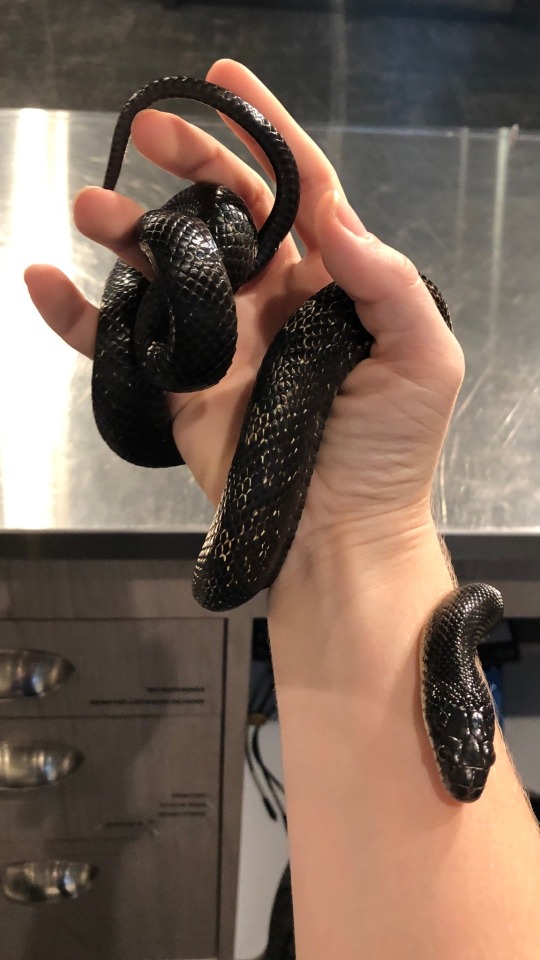
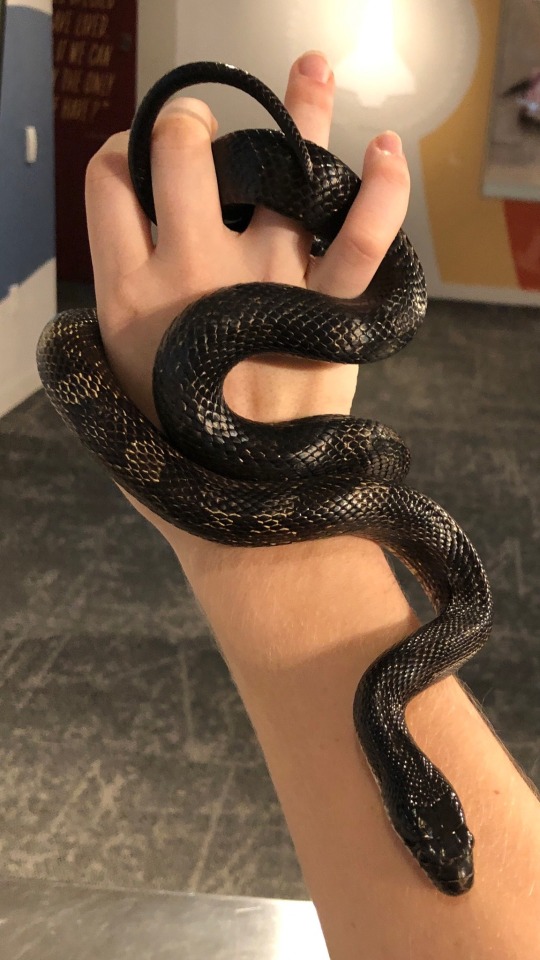
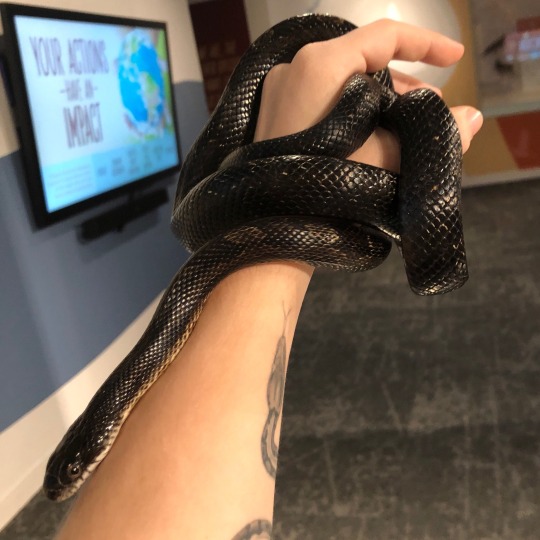
noodle boy Linguine
#Linguine#gray rat snake#snake#reptile#Pantherophis spiloides#reptiblr#snek friend#CMNH#Oct 2022#just realized I spelled Noodle wrong after 268 notes whoops
321 notes
·
View notes
Link
Hi friends if you wanna help me raise money for Children’s Miracle Network Hospitals I’d really appreciate it!!! I’ll even shout you out on my page to 6K followers :) any amount helps
#aesthetic#donate#help plz#donations#cmnh#children's miracle network hospitals#phi mu#sorority#philanthropy
5 notes
·
View notes
Photo

#DINOSAURS !!! @gocmnh #CMNH (at Cleveland Museum of Natural History) https://www.instagram.com/p/B3vJ0pLpgJc/?igshid=1421e5oawsptx
1 note
·
View note
Photo

via Giphy
3 notes
·
View notes
Text
CMNH in Pittsburgh does it by time, and has the fossils staged in realistic poses/environments.
494 notes
·
View notes
Text
Illustrations of Flora in Western Pennsylvania

In 1941, Carnegie Museum of Natural History Director Andrey Avinoff began an ambitious project with friend and Curator of Botany Otto E. Jennings.
They wanted to describe and illustrate the flora of western Pennsylvania, based on Jennings’s lifelong study of the region. Jennings and his colleagues brought in the living plants, fresh and unwithered. Avinoff worked quickly to capture accurately the color and manner of growth. Many of these specimens were then dried, pressed, and placed as vouchers in the herbarium.
Selected Avinoff reprints are available in the Museum Store for purchase for $25.
68 notes
·
View notes
Photo

1 note
·
View note
Photo

1 note
·
View note
Photo

Lake Erie is an invaluable resource and habitat. It’s the shallowest, warmest and most biologically diverse of the five Great Lakes. Its waters and watershed support a bounty of aquatic and terrestrial life, including dozens of species of native fish, plants, amphibians, mammals and insects. The lake provides drinking water for 11 million Americans and Canadians. After decades of neglect and decline during much of the 20thcentury, Lake Erie rebounded during the 1980s and ‘90s, due to intensive efforts focused on reducing industrial pollution and storm water runoff. But in the early 21stcentury, Lake Erie is facing renewed environmental threats, including harmful algal blooms, low-oxygen conditions, invasive species and the impact of climate change.
2 notes
·
View notes